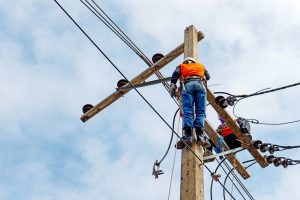The Occupational Safety and Health Administration (OSHA) urged employers in the Midwest to emphasize electrical safety following four workplace fatalities in Kansas and Missouri.
A 41-year-old in Wichita, Kansas, doing heating and air conditioning work on July 13; a 35-year-old electrical contractor climbing a pole in Lawrence, Kansas, on June 8; a 40-year-old electrical contractor in Sedalia, Missouri, replacing light fixtures on October 4; and a 22-year-old worker cleaning a Higbee, Missouri, pig barn with a pressure washer on September 23 all died of electrocution.
The agency is alerting all employers to review safe electrical work practices with their employees in response to a nationwide increase in workplace deaths by electrocution as it continues its investigations into the four employer-reported deaths.
The Labor Department’s Bureau of Labor Statistics (BLS) reported a 3.75 percent increase nationally in workplace deaths related to electrocution in 2019 over the previous year; the BLS has not yet released its data on fatal occupational injuries during 2020. OSHA investigated 12 electrical-related deaths in Missouri and Kansas from November 6, 2018, through October 3, 2021.
OSHA has a local emphasis program (LEP) in the St. Louis area for electrical hazards in industry and an alliance agreement to promote electrical safety with the Iowa Department of Workforce Development and the International Brotherhood of Electrical Workers 55.
“Recent tragedies in Missouri and Kansas are reminders of the danger of electrical exposures in the workplace,” OSHA’s Acting Kansas City Regional Administrator Billie Kizer said in an agency statement. “Employers should implement safety and health programs and are required to train workers on identifying hazards and use required protective measures to ensure all employees end each workday safely.”
Manufacturer cited for cadmium, hexavalent chromium violations
OSHA cited a Connecticut aircraft parts manufacturer for failing to identify potential exposures and protect employees from hexavalent chromium and cadmium, both known carcinogens. The agency cited Kaman Air Vehicles with two willful, four serious, and two other-than-serious violations at its Bloomfield, Connecticut, facility and proposed $308,168 in penalties.
OSHA conducted the inspection under its National Emphasis Program (NEP) on hexavalent chromium. Inspectors determined that employees at Kaman Air Vehicles faced exposure and possible overexposure to toxic substances while electroplating, mixing and preparing, and painting and removing paint on small aircraft parts.
OSHA inspectors concluded that the company failed to:
- Determine employees’ exposure to hexavalent chromium, and implement controls and work practices to reduce employees’ overexposure to chromium.
- Provide employees with appropriate information and training on chromium hazards.
- Assess employees’ overexposure to cadmium during plating operations.
- Provide employees with appropriate personal protective equipment (PPE), including chemical-resistant gloves and impervious aprons, and ensure their use.
- Ensure exposed employees used effective respiratory protection.
- Periodically examine nostrils of exposed employees.
- Label tanks containing hazardous substances with information on the hazards associated with their contents.
“Our inspection found Kaman Air Vehicles failed to protect employees as required from potentially serious health conditions,” Acting Hartford, Connecticut, Area Director Christine George said in an agency statement.
“This employer must ensure a safe, healthful work environment by monitoring worker exposure, implementing controls to reduce and minimize exposure levels and provide employees with information about the toxic substances with which they work.”

